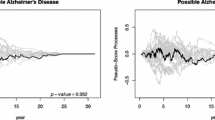Abstract
We consider a situation which is common in epidemiology, in which several transformations of an explanatory variable are tried in a Cox model and the most significant test is retained. The p-value should then be corrected to take account of the multiplicity of tests. Bonferroni method is often too conservative because the tests may be highly positively correlated. We propose an asymptotically exact correction of the p-value. The method uses the fact that the tests are asymptotically normal to compute numerically the distribution of the maximum of several tests. Counting processes theory is used to derive estimators of the correlations between tests. The method is illustrated by a simulation and an analysis of the relation between concentration of aluminum in drinking water and risk of dementia.
Similar content being viewed by others
References
D. G. Altman, B. Lausen, W. Sauerbrei, and M. Shumacher, “Dangers of using “optimal” cutpoints in the evaluation of prognostic factors,” Journal of the National Cancer Institute vol. 86 pp. 829–835, 1994.
P. K. Andersen, Ø. Borgan, R. D. Gill, and N. Keiding, Statistical Models Based on Counting Processes, Springer-Verlag: New York, 1993.
P. Armitage, C. K. McPherson, and B. C. Rowe, “Repeated significance tests on accumulating data,” Journal of Royal Statistical Society ser. A vol. 132 pp. 235–244, 1969.
J. D. Birchall and J. S. Chappell, “Aluminum, water chemistry and Alzheimer's disease,” Lancet 953, 1989.
D. Commenges, L. Letenneur, P. Joly, A. Alioum, and J. F. Dartigues, “Modelling age-specific risk: application to dementia,” Statistics in Medicine vol. 17 pp. 1973–1988, 1998.
D. Commenges and V. Rondeau, “Standardized martingale residuals applied to grouped left-truncated observations of dementia cases,” Lifetime Data Analysis vol. 6 pp. 229–235, 2000.
B. Efron, “The length heuristic for simultaneous hypothesis,” Biometrika vol. 84 pp. 143–157, 1997.
T. R. Fleming and D. P. Harrington, Counting Processes and Survival Analysis, Wiley: New-York, 1991.
A. Genz, “Numerical computation of multivariate normal probabilities,” J. Computat. and Graphic. statist. vol. 47 pp. 141–149, 1992.
J. Hastie and R. J. Tibshirani, Generalized Additive Models, Chapman and Hall: London, 1990.
P. Joly, D. Commenges, C. Helmer, L. Letenneur, “A penalized likelihood approach for an illness-death model with interval-censored data: application to age-specific incidence of dementia,” Biostatistics, in press.
J. A. Koziol, “On maximally selected chi-Square statistics,” Biometrics vol. 47 pp. 1557–1561, 1991.
B. Lausen and M. Schumacher, “Evaluating the effect of optimized cutoff values in the assessment of prognostic factors,” Computational Statistics & Data Analysis vol. 21 pp. 307–326, 1996.
B. Lausen and M. Schumacher, “Maximally selected rank statistics,” Biometrics vol. 48 pp. 73–85, 1992.
B. Liquet and D. Commenges, “Correction of the P-value after multiple coding of an explanatory variable in logistic regression,” Statistic in Medicine vol. 20 pp. 2815–2826, 2001.
C. N. Martyn, D. J. Barker, C. Osmond, E. C. Harris, J. A. Edwardson, R. F. Lacey, “Geographical relation between Alzheimer's disease and aluminum in drinking water,” Lancet vol. 1 pp. 59–62, 1989.
C. N. Martyn, D. N. Coggon, H. Inskip, R. F. Lacey, W. F. Young, “Aluminum concentrations in drinking water and risk of Alzheimer's disease,” Epidemiology vol. 8 pp. 281–2866, 1997.
R. Miller, Simultaneous Statistical Inference, Springer-Verlag: New York, 1981.
R. Miller and D. Siegmund, “Maximally selected chi-square statistics,” Biometrics vol. 38 pp. 1011–1016, 1982.
V. Rondeau, D. Commenges, H. Jacqmin-Gadda, and J. F. Dartigues, “Relationship between aluminium and silica concentrations in drinking water and Alzheimer's disease: an 8-year follow-up study,” American Journal of Epidemiology vol. 152 pp. 59–66, 2000.
M. Schumacher, N. Hollander, and W. Sauerbrei, “Resampling and cross-validation techniques: a tool to reduce bias caused by model building,” Statistic in Medicine vol. 16 pp. 2813–2827, 1997.
Author information
Authors and Affiliations
Rights and permissions
About this article
Cite this article
Hashemi, R., Commenges, D. Correction of the p-Value after Multiple Tests in a Cox Proportional Hazard Model. Lifetime Data Anal 8, 335–348 (2002). https://doi.org/10.1023/A:1020514804325
Issue Date:
DOI: https://doi.org/10.1023/A:1020514804325




